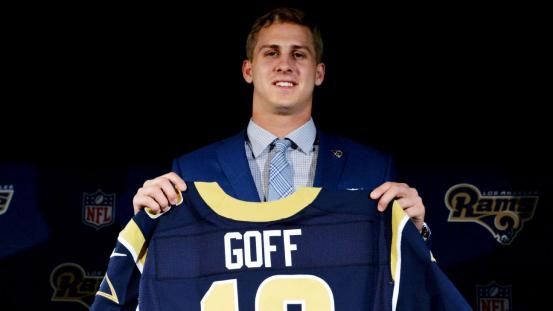- Commissioner’s statement on Ventura, Marte
- Ronnie O’Sullivan: Masters champion ‘felt so vulnerable’ in final
- Arron Fletcher Wins 2017 WSOP International Circuit Marrakech Main Event ($140,224)
- Smith challenges Warner to go big in India
- Moncada No. 1 on MLB Pipeline’s Top 10 2B Prospects list
- Braves land 2 on MLB Pipeline’s Top 10 2B Prospects list
- Kingery makes MLB Pipeline’s Top 10 2B Prospects list
- New Zealand wrap up 2-0 after Bangladesh implosion
- Mathews, Pradeep, Gunathilaka to return to Sri Lanka
- Elliott hopes for rain for Poli
Ten takeaways from the NFL draft: Which rookie QBs will start Week 1?
- Updated: April 30, 2016

7:04 PM ET
It’s over! The 2016 NFL draft is in the books. You’ve read a ton about it already, so here’s a little more. Forthwith: Ten unique, witty and insightful takeaways to the affair.
1. Only one rookie quarterback will start in Week 1
That’s the way I see it here on the final day of April, at least.
There is more than one quarterback in this draft capable of starting immediately, and injuries could always change the equation. But the player-team matches suggest that only Jared Goff, who went No. 1 overall, will enter the season atop his team’s depth chart.
Goff is the most pro-ready quarterback in this class, and he’ll need only to beat out the venerable Case Keenum and Nick Foles in order to be the starter Sept. 12 at the San Francisco 49ers.
With Jared Goff in the fold, the Rams have now used the first overall pick on a quarterback twice in the past seven years. Kirby Lee/USA TODAY Sports
Think about it. The Philadelphia Eagles have 34 million reasons (via money guaranteed to Sam Bradford and Chase Daniel) to avoid rushing Carson Wentz. The Denver Broncos will have Mark Sanchez at their disposal while they teach Paxton Lynch how to take a snap from center.
The New York Jets still are trying to re-sign Ryan Fitzpatrick, but even if they move on, they could start Geno Smith or Bryce Petty while rebuilding Christian Hackenberg’s mechanics and confidence. Connor Cook could have competed for a starting job with some teams, but after falling to the Oakland Raiders in the fourth round, he’s destined to back up Derek Carr.
The other 11 quarterbacks drafted, from Cody Kessler (Cleveland Browns) to Dak Prescott (Dallas Cowboys) to Cardale Jones (Buffalo Bills), are all projected as long-term backups. If any of them start in Week 1, or at all in 2016, it will be after a massive organizational disaster of some kind.
This 15-man class was the NFL’s largest since 2004 and stood in stark contrast to the seven-man group of 2015, the smallest in the draft’s common era history. But it has been six years since fewer than two rookie quarterbacks earned Week 1 starting jobs. That happened in 2010, also for the Rams (in St. Louis) and also for a No. 1 overall pick (Bradford). The recent high came in 2012, when five rookies — Andrew Luck, Robert Griffin III, Brandon Weeden, Ryan Tannehill and Russell Wilson — each started in Week 1.
2. The Browns’ Way
We’ve long since established that the Browns’ new front office, led by former team attorney Sashi Brown and longtime baseball executive Paul DePodesta, is going to go about its business in an unconventional way. And it’s pretty clear the team is taking a (very) long-term approach, as evidenced by the decision to grab what can only be considered their backup quarterback of the future (Kessler, in the third round) before they draft a long-term starter.
(If you’re thinking of RG III as anything other than a flyer, you’re fooling yourself.)
But here’s one way the Browns’ approach could help them in 2016. Their aggressiveness in acquiring draft picks, both for now and in future years, allowed them to address an excruciating area of weakness with the kind of volume that should significantly increase their chances of a few immediate hits.
With an NFL-high 14 picks overall this year, the Browns drafted five wide receivers. No team has done that, or been able to do that, since the New Orleans Saints in 1967 — when the draft was 17 rounds. With so many picks at their disposal, the Browns were still able to take two defensive ends, two offensive tackles, two defensive backs, a linebacker and a quarterback.
Many personnel evaluators like to think they can identify talent better than their competitors. Most statistical studies, in terms of draft hits and misses, show that not to be the case. Volume is what analytics tells us might be more important to draft success, and it’s now clear the Browns will be a case study in that theory moving forward.
Corey Coleman, out of Baylor, was one of five receivers the Browns drafted this year. Jon Durr/Getty Images
Already thinking about 2017? The Browns have two picks in the first round and another two in the second as a result of their trade maneuvers. They also have an extra second-round pick in 2018.
3. The quarterback as a commodity
This draft showed us the value of regularly drafting quarterbacks, regardless of the team’s current situation.
The Patriots have made a habit of it during the Tom Brady era. Jacoby Brissett was the eighth quarterback they’ve drafted since Brady in 2000, a group that includes Matt Cassel, Kevin O’Connell, Ryan Mallet and Jimmy Garappolo. …
continue reading in source espn.go.com
